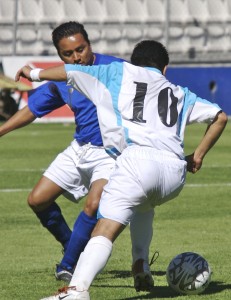 There are a couple of ways to tackle in soccer, and each carry different advantages.
There are a couple of ways to tackle in soccer, and each carry different advantages.
One method is called block tackling as described in the the excellent book Soccer: How to Play the Game: The Official Manual of the United States Soccer Federation.
Block tackling is just like it sounds: you place your foot in front of the soccer ball to “block” the ball from going forward. Your foot should be acting like a wall.
There are a few key components to block tackling. The method is similar to the way you perform a push pass or a pass with the instep. You want to use the instep of your tackling foot by opening up your hips, your toe should be slightly pointed up, and your ankle locked.
In block tackling, you want your tackling foot to make contact with the soccer ball slightly above the center of the ball so you will force the momentum of the tackle into the ground allowing the ball to stay in front of you and not hurt your leg.
One key difference in block tackling and performing a push pass, though, is how you finish the skill. When performing a push pass, you swing through the center half of the ball and show your heel, whereas when performing a block tackle, you DO NOT SWING through the soccer ball.
If you swing through the soccer ball in a block tackle, you run the risk of pulling a muscle, hurting your ankle, knee, or even breaking your leg. Instead of swinging, you just want to block the soccer ball from traveling forward.
Another key component in block tackling is keeping your weight behind the ball and your shoulders slightly leaning forward so that you are well balanced. If you lean too far forward, then you be too top-heavy and fall forward over the soccer ball, losing the tackle.
If you are too far back, then you will most likely win the first challenge but you will be on your heels not allow you to win the second challenge.
These are the basics of block tackling. Stay tuned for our next post on different types of challenges, including 50/50 and 60/40 challenges. As always, leave us a comment if this tip was helpful or if you have any additional questions.
photo contrapart
